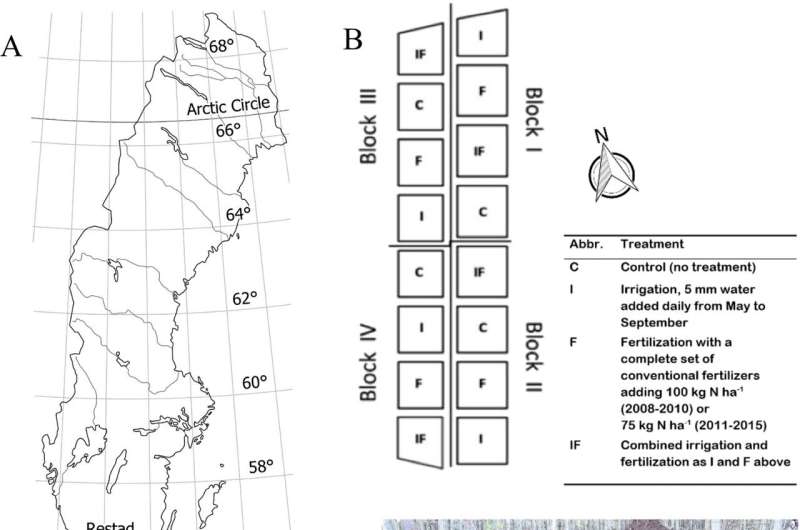This article has been reviewed according to Science X's editorial process and policies. Editors have highlighted the following attributes while ensuring the content's credibility:
fact-checked
peer-reviewed publication
proofread
Study: Fertilization unnecessary in oak forests planted on former agricultural land

Low availability of nutrients often limits productivity in northern forests. In a trial with nutrient optimization, researchers at Linnaeus University have studied the effects of fertilization and irrigation in 25-year-old stands of pedunculate and sessile oak that grow on former agricultural land in southwest Sweden.
The results, which have been published in Forest Ecology and Management, show that fertilization does not lead to increased production and it does only cause a small increase, or none at all, in the water uptake of the oaks.
The main reason to use fertilization is to make the trees grow faster and become thicker. Increased growth in oaks and other ring-porous deciduous trees also leads to harder wood, which is favorable in, for instance, the flooring industry. However, for our coniferous trees, like spruce and pine, increased growth leads to somewhat softer wood. Though a new study shows that fertilization does not always result in a higher production.
Nutrients from the soil fully sufficient
"The results indicate that nutrient supply in oak stands with precipitation levels similar to that of the trial stand, does not require simultaneous irrigation. Fertilization on this type of land does not lead to any increased growth. The soil nutrients form former agricultural use is sufficient to maximize productivity in oak stands on former agricultural land, which is a common type of land for planting new oak stands in southwest Sweden," explains Carl Svensson, doctoral student in silviculture, whose research focuses on the nutrient dynamics of the forest.
Foliage not affected by irrigation
It is well known from previous studies that fertilization increases the uptake of water, and this is directly linked to increased growth, in particular to an increase in green leaves.
"However, in our study, the foliage did not increase, and, to some extent, this can be explained by the fact that the trees are now so big that there is not enough space in the canopy for the foliage to continue to develop. However, our measurements of tree growth in height and stem diameter, as well as measurements of soil water content, we claim show that the main explanation is that the soil is already rich in nutrients, thanks to historical fertilization during the long era when it was used as agricultural land," Svensson continues.
Useful for forest owners
The results can be used primarily when counseling forest owners in southern Sweden who own abandoned agricultural land. This land can be used for high production of oak, without having to add any nutrients, as fertilization during former land use has given the soil a consistent increased level of nutrients, making it fully sufficient to provide for a new generation of oak forest.
"In the long term, this could lead to a greater offer of oak floors and oak furniture. In the short term, planting new oak stands on abandoned agricultural land would increase the sequestration of carbon, which contributes to mitigating climate changes. And that affects us all," Svensson concludes.
More information: Carl Svensson et al, Fertilisation and irrigation have no effects on growth of oak (Quercus robur, Q. petraea) stands on abandoned farmland in southwest Sweden, Forest Ecology and Management (2022). DOI: 10.1016/j.foreco.2022.120700
Journal information: Forest Ecology and Management
Provided by Schwedischer Forschungsrat





















